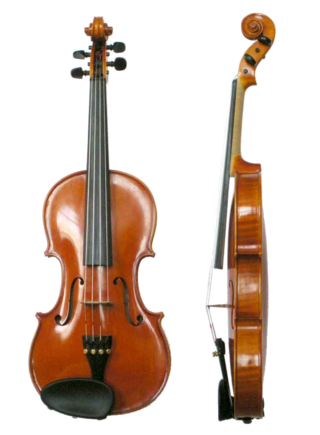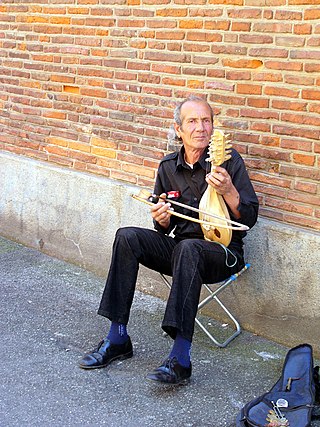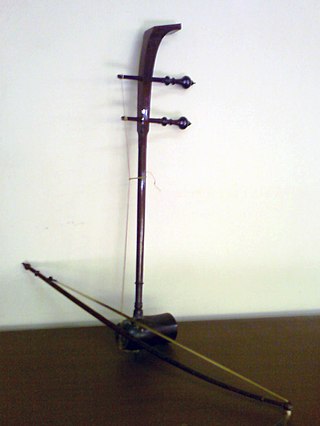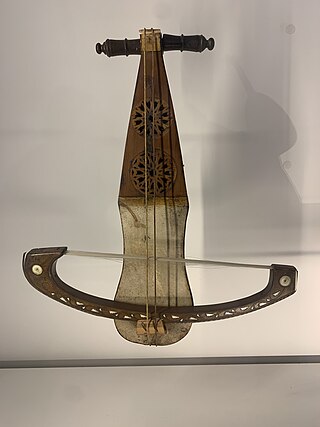
The violin, sometimes referred as a fiddle, is a wooden chordophone, and is the smallest, and thus highest-pitched instrument (soprano) in regular use in the violin family. Smaller violin-type instruments exist, including the violino piccolo and the pochette, but these are virtually unused. Most violins have a hollow wooden body, and commonly have four strings, usually tuned in perfect fifths with notes G3, D4, A4, E5, and are most commonly played by drawing a bow across the strings. The violin can also be played by plucking the strings with the fingers (pizzicato) and, in specialized cases, by striking the strings with the wooden side of the bow.

In musical instrument classification, string instruments, or chordophones, are musical instruments that produce sound from vibrating strings when a performer plays or sounds the strings in some manner.

The gadulka is a traditional Bulgarian bowed string instrument. Alternate spellings are "gǎdulka", "gudulka" and "g'dulka". Its name comes from a root meaning "to make noise, hum or buzz". The gadulka is an integral part of Bulgarian traditional instrumental ensembles, commonly played in the context of dance music.

The erhu is a Chinese two-stringed bowed musical instrument, more specifically a spike fiddle, which may also be called a southern fiddle, and is sometimes known in the Western world as the Chinese violin or a Chinese two-stringed fiddle.

The kamancheh is an Iranian bowed string instrument used in Persian, Azerbaijani, Armenian, Kurdish, Georgian, Turkmen, and Uzbek music with slight variations in the structure of the instrument. The kamancheh is related to the rebab which is the historical ancestor of the kamancheh and the bowed Byzantine lyra. The strings are played with a variable-tension bow.
Bowed string instruments are a subcategory of string instruments that are played by a bow rubbing the strings. The bow rubbing the string causes vibration which the instrument emits as sound.
The musical traditions of Central Asia mirror the immense diversity found in the cultures and populations residing in the region. Principal instrument types are two- or three-stringed lutes, the necks either fretted or fretless; fiddles made of horsehair; flutes, mostly sige at both ends and either end-blown or side-blown; and jew harps, mostly metal. Percussion instruments include frame drums, Tam origin of the bowed string Use of the bowed string is thought to originate with nomads who mainly used the snake-skin, covered horsetail-bowed lute. In Mongolia instruments like the morin khuur or horse-head fiddle survive today.

The rebab is the name of several related string instruments that independently spread via Islamic trading routes over much of North Africa, Middle East, Central Asia, Southeast Asia, and parts of Europe. The instrument is typically bowed, but is sometimes plucked. It is one of the earliest known bowed instruments, named no later than the 8th century, and is the parent of many bowed and stringed instruments.

Huqin is a family of bowed string instruments, more specifically, a spike fiddle popularly used in Chinese music. The instruments consist of a round, hexagonal, or octagonal sound box at the bottom with a neck attached that protrudes upwards. They also usually have two strings, and their soundboxes are typically covered with either snakeskin or thin wood. Huqin instruments usually have two tuning pegs, one peg for each string. The pegs are attached horizontally through holes drilled in the instrument's neck. Most huqin have the bow hair pass in between the strings. Exceptions to having two strings and pegs include variations of huqin with three, four, and sometimes even more than five. These include the zhuihu, a three stringed huqin, the sihu, a huqin of Mongolian origin, and the sanhu, a lesser-known three-stringed variation.

The tro is Cambodia's traditional spike fiddle, a bowed string instrument that is held and played vertically. Spike fiddles have a handle that passes through the resonator, often forming a spike, on the bottom side where it emerges. The family is similar or distantly related to the Chinese erhu or huqin. The instruments have a soundbox at the bottom of the stick, covered with leather or snake skin. Strings run from pegs at the top of the stick and secured at the bottom, running across the soundbox. The larger the soundbox, the lower the pitch range. Instruments in this family include the two-stringed tro ou, tro sau thom, tro sau toch and tro che, as well as the three-stringed tro Khmer spike fiddle. The two-stringed tros are tuned in a fifth, while the three-stringed tro Khmer is tuned in fourths. The tros, with the exception of the tro Khmer, are strung so that the bowstring is permanently placed between the two stings. When the musician plays, the placement of the bow causes the strings to be played at once, one from below and one from above. In contrast, western fiddles are played with the bow pushing on each string from the outside, as is also the case with the tro khmer.

The tro Khmer is a traditional bowed string instrument from Cambodia. Its body is made from a special type of coconut covered on one end with snake skin, and it has three strings. Instruments are not standardized, and coconuts vary in size; however the instrument's sound bowl may have dimensions 16.5 cm by 14 cm. In the past the strings were made of silk. By the 1960s, metal strings were in use, and the sound of the instrument changed, becoming sharper.
Traditional Thai musical instruments are the musical instruments used in the traditional and classical music of Thailand. They comprise a wide range of wind, string, and percussion instruments played by both the Thai majority as well as the nation's ethnic minorities.

The saw duang is a two-stringed instrument used in traditional Thai music. The sound is produced by the bow made from horsetail hair which goes between the strings made from silk. The bow has to be tilted to switch from one string to another. Saw duang is light and played vertically on the lap. It creates a bright tone unlike the Saw u which produces a mellow sound. Another instrument which is similar to the Saw duang is the Chinese stringed instrument called Huqin.

The saw u is a Thai bowed string instrument. It has a lower pitch than the saw duang and is the lowest sounding of the saw family.

The Byzantine lyra or lira was a medieval bowed string musical instrument in the Byzantine Empire. In its popular form, the lyra was a pear-shaped instrument with three to five strings, held upright and played by stopping the strings from the side with the fingertips and fingernails. The oldest known depiction of the instrument is on a Byzantine ivory casket, dated to circa 900–1100 AD, preserved in the Bargello in Florence. Modern variants of the lyra are still played throughout the Balkans and in areas surrounding the Black Sea, including Greece, Crete, Karpathos, Albania, Montenegro, Serbia, Bulgaria, North Macedonia, Croatia, Italy, Turkey and Armenia.
The Kemençe of the Black Sea is a Greek and Turkish traditional musical instrument. It belongs to the category of stringed bowed musical instruments. It has three strings, usually tuned to perfect fourths, usually tuned B-E-A. It is the pre-eminent musical folk instrument of the Greeks of Pontus. It seems to have been invented during the Byzantine years, between the 11th and 12th centuries. The instrument is made of different types of wood.

The classicalkemenche, Armudî kemençe or Politiki lyra is a pear-shaped bowed instrument that derived from the medieval Greek Byzantine lyre.
The Saw bang is a bowed musical instrument. It differs from a related Saw by using only bamboo for its sound box and skull fiddle (กะโหลกซอ). The bamboo is called " Mị̂ ku (ไม้กุ) ". It is sun-dried and then the bark is taken off. Holes are made and strings are stretched with the knob which are made from two pieces of wood wedge.

Lutes are stringed musical instruments that include a body and "a neck which serves both as a handle and as a means of stretching the strings beyond the body".

The Maghreb rebab or Maghrebi rebab is a bowed lute now played mainly in Northern Africa. It fits within the wider rebab traditions of the Arab world, but also branched into European musical tradition in Spain, Sicily, and the Holy Roman Empire. In the late Middle Ages, the European rebec developed from this instrument. The Maghreb rebab was described by a musicologist as the "predominant" rebab of North Africa, although the instrument was in decline with younger generations when that was published in 1984.


















